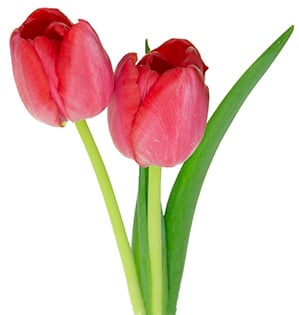Tulip - Single Rounded

Common Names: Tulip, Tulipa
Botanical names: Tulipa, (TEW-li-pa)
Availability: November through May; limited availability year round
Vase life: 3 to 7 days
Storage temperatures: 32 - 34 degrees Fahrenheit
Ethylene Sensitive: No
Description: Deep cup-shaped blossoms, 2 to 4 inches high born on solid stems 12 to 24 inches high. Tulip blossoms are grouped into four categories; single-rounded, double-rounded, parrot (fringed), and lily flowered (pointed petals).
Color: Red, pink, white, yellow, orange, purple and bi-colors
Botanical facts: The name is from the Turkish word tulband, for turban.
Design notes: These colorful blossoms are commonly displayed as a mono-botanical in a vase arrangement. They are frequently used in mixed spring arrangements, hand-tie bouquets, landscape, vegetative, and botanical design styles.
Purchasing hints: Select stems with turgid foliage and tight flower heads and just beginning to show color. The stems should be straight and strong.
Conditioning: Cut the ends of the stems with a sharp knife removing all of the white portion of the stem. Hydrate in a solution of water and commercial floral food for two hours before storage or usage. To keep stems straight, wrap a bundle of stems in paper while the flowers are conditioning. NOTE: Tulips are very sensitive to, and will be harmed by the sap from Narcissus, Daffodils. NOTE: Tulips can cause an allergic dermatitis in some individuals. While this is not common among floral designers, and usually occurs after extended exposure to a large volume of product, care should be exercised when handling tulips. Anyone handling tulips should wash their hands with soap and water after exposure. Individuals who prove to be sensitive to tulips should handle the product with gloves. Always seek medical attention if an allergic reaction is severe. The allergic dermatitis is common among tulip bulb planters, and is known as "tulip finger".
Additional notes: Tulips are very phototropic and will curve rapidly toward the light. Designers must allow for this in creating a floral design as well as the fact that cut tulips continue to grow in length approximately one inch per day. The name tulip comes from the Turkish for turban, referring to the shape of the flower bud; although native to that area of the world, tulips are now grown throughout the world. Many people associate them with Holland: "Tulips from Amsterdam," as the song goes. But even before a European envoy found them in the ornamental gardens of a Turkish sultan, they were popular with the Indian shahs. They were originally native to Turkey, Iran, Syria and parts of Asia and have been cultivated in Europe since the 16th century. It was the Dutch who began to breed them in 1593 and by 1633 the Dutch upper classes were gripped by "Tulip Mania," the frenzied trading in tulip bulbs. Prized tulip bulbs were selling for astronomical prices. Fortunes were made in trading tulip futures (primarily by tulip bulb merchants), and fortunes were lost. As in so many "hot stock markets" (dot.com comes to mind), buyers eventually realized that a tulip bulb was just a tulip bulb. There is an enormous range of colors and shapes, from double tulips, which resemble roses, to lily-flowered ones with elegant pointed petals and the wonderful fringed or contorted two- or three-toned parrot tulips. Research has shown that people see tulips as sophisticated and stylish. They like them to curve towards the light, for tulips continue to grow strongly after cutting. Some like them bold and upright and, for this, a light source above the flower heads will do the trick. Certainly, their strong form suits modern interiors very well and mixed with other flowers, they bring focus to informal and hand-tied bouquets. The tulip never goes out of fashion; it is merely displayed in different ways in different eras.

